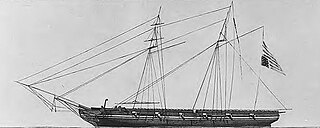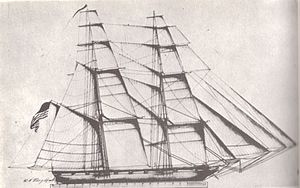
William Bainbridge was a Commodore in the United States Navy. During his long career in the young American Navy he served under six presidents beginning with John Adams and is notable for his many victories at sea. He commanded several famous naval ships, including USS Constitution, and saw service in the Barbary Wars and the War of 1812. Bainbridge was also in command of USS Philadelphia when she grounded off the shores of Tripoli, Libya in North Africa, resulting in his capture and imprisonment for many months. In the latter part of his career he became the U.S. Naval Commissioner.

The third US ship to be named Enterprise was a schooner, built by Henry Spencer at Baltimore, Maryland, in 1799. Her first commander thought that she was too lightly built and that her quarters, in particular, should be bulletproofed. Enterprise was overhauled and rebuilt several times, effectively changing from a twelve-gun schooner to a fourteen-gun topsail schooner and eventually to a brig. Enterprise saw action in the Caribbean, the Mediterranean, and the Caribbean again, capturing numerous prizes. She wrecked in July 1823.

USS Columbus was a 92-gun ship of the line in the United States Navy. Although construction of the warship was authorized by Congress on 2 January 1813, plunder of the Washington Navy Yard by British troops in 1814 during the burning of Washington, combined with efforts to keep US military stores out of British hands, led to the destruction of any initial framing. Days after Congress re-authorized the vessel on 29 April 1816, a keel was laid and construction resumed.

USS Congress was a nominally rated 38-gun wooden-hulled, three-masted heavy frigate of the United States Navy. James Hackett built her in Portsmouth New Hampshire and she was launched on 15 August 1799. She was one of the original six frigates whose construction the Naval Act of 1794 had authorized. The name "Congress" was among ten names submitted to President George Washington by Secretary of War Timothy Pickering in March 1795 for the frigates that were to be constructed.Joshua Humphreys designed these frigates to be the young Navy's capital ships, and so Congress and her sisters were larger and more heavily armed and built than the standard frigates of the period.

Master Commandant William Henry Allen was an American naval officer during the War of 1812.

The third USS Hornet was a brig-rigged sloop-of-war in the United States Navy. During the War of 1812, she was the first U.S. Navy ship to capture a British privateer.

USS Syren was a brig of the United States Navy built at Philadelphia in 1803. She served during the First Barbary War and the War of 1812 until the Royal Navy captured her in 1814. The British never commissioned her but apparently used her for a year or so as a lazaretto, or a prison vessel. She then disappears from records.
The first USS George Washington was a frigate in the United States Navy. She was named after United States Founding Father and President George Washington.

USS Lynx, a 6-gun Baltimore Clipper rigged schooner, was built for the United States Navy by James Owner of Georgetown, Washington, D.C., in 1814, intended for service in one of the two raiding squadrons being built as part of President James Madison's administration’s plan to establish a more effective Navy, one capable not only of breaking the British naval blockade, but also of raising havoc with the British merchant marine.
The second USS Ontario was a three-masted, wooden-hulled sloop of war in the United States Navy, bearing 16 guns, and saw service during and following the years of the War of 1812 and in the Second Barbary War. Ontario was built by Thomas Kemp, Baltimore, Maryland, in 1813; blockaded in Chesapeake Bay through the War of 1812; and sailed from New York for the Mediterranean on 20 May 1815, Master Commandant Jesse D. Elliott in command.

USS Guerriere was the first frigate built in the United States since 1801. The name came from a fast 38-gun British frigate captured and destroyed in a half-hour battle by USS Constitution on 19 August 1812. This victory was one of the United States' first in the War of 1812.
USS Java was a wooden-hulled, sailing frigate in the United States Navy, bearing 44 guns. She was named for the American victory over HMS Java off the coast of Brazil on 29 December 1812, captured by the Constitution under the command of Captain William Bainbridge. HMS Java had suffered severe damage during the engagement and being far from home port was ordered burned.

The Mediterranean Squadron, also known as the Mediterranean Station, was part of the United States Navy in the 19th century that operated in the Mediterranean Sea. It was formed in response to the First and Second Barbary Wars. Between 1801 and 1818, the squadron was composed of a series of rotating squadrons. Later, squadrons were sent in the 1820s to the 1860s to suppress piracy, primarily in Greece and to engage in gunboat diplomacy. In 1865 the force was renamed the European Squadron.

USS Chippewa was a brig built in 1815 at Warren, Rhode Island, under the direction of Commodore Oliver Perry, and sent to New York City to be outfitted and manned. Chippewa sailed from Boston, Massachusetts, 3 July 1815, with Lieutenant George C. Read in command, as a part of a squadron under the command of Commodore William Bainbridge. It was intended to go to the Mediterranean for use against the Barbary pirates based in North Africa.
USS Spitfire was the former Baltimore privateer Grampus that the United States Navy purchased. She was a heavily armed schooner built for service in the War of 1812, but did not see service until the Barbary Wars when she was sent with the American fleet to the Mediterranean to force an end to piracy of American ships.

The West Indies Squadron, or the West Indies Station, was a United States Navy squadron that operated in the West Indies in the early nineteenth century. It was formed due to the need to suppress piracy in the Caribbean Sea, the Antilles and the Gulf of Mexico region of the Atlantic Ocean. This unit later engaged in the Second Seminole War until being combined with the Home Squadron in 1842. From 1822 to 1826 the squadron was based out of Saint Thomas Island until the Pensacola Naval Yard was constructed.

Aegean Sea anti-piracy operations began in 1825 when the United States government dispatched a squadron of ships to suppress Greek piracy in the Aegean Sea. The Greek civil wars of 1824–1825 and the decline of the Hellenic Navy made the Aegean quickly become a haven for pirates who sometimes doubled as privateers.

The West Indies Anti-Piracy Operations refer to the United States Navy presence in the Antilles, and surrounding waters, which fought against pirates. Between 1817 and 1825, the American West Indies Squadron constantly pursued pirates on sea and land, primarily around Cuba and Puerto Rico. After the capture of Roberto Cofresi in 1825, acts of piracy became rare, and the operation was considered a success, although limited occurrences went on until slightly after the start of the 20th century.

Stephen Decatur Jr. was an American naval officer and commodore. He was born on the eastern shore of Maryland in Worcester County. His father, Stephen Decatur Sr., was a commodore in the United States Navy who served during the American Revolution; he brought the younger Stephen into the world of ships and sailing early on. Shortly after attending college, Decatur followed in his father's footsteps and joined the U.S. Navy at the age of nineteen as a midshipman.

The USS Firefly, was a brig with two masts, square-rigged, formerly named Volant and originally built as a schooner for use as a privateer. The U.S. Navy purchased Volant on 8 December 1814 at New York by and was fitted her out as US naval 14-gun brig. She served during the War of 1812 and Second Barbary War of 1815. Firefly was purchased because of the several US blockade efforts where smaller ships with better maneuverability were needed for the task. The Navy sold her in 1816 and she became a Portuguese slave ship.















